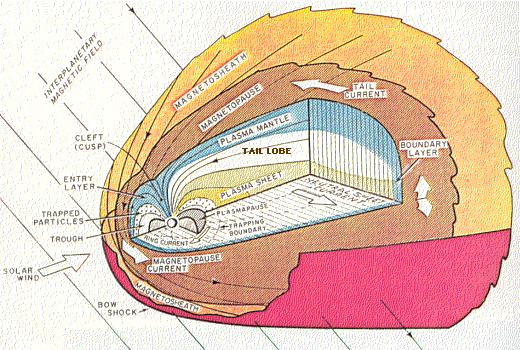
More detailed info:
University of Oulu's (Finland) Magnetosphere section in their Space Physics Textbook
NASA's Magnetospheric Multiscale Mission
There is no sharp boundary between the ionosphere and the magnetosphere. The mid and low latitude ionosphere is connected to the plasmasphere, whereas the high latitude ionosphere is directly connected to the outer magnetosphere through the polar cusps. The high latitude ionosphere receives a polar rain (actually it's more like a drizzle) of electrons from the solar wind and is also the source of a polar wind of O+ ions into the magnetosphere.
Where are the "noises" coming from?
Some prefer to call them Earth Songs.
Samples and live audio stream from the INSRIRE VLF radio receiver at the Marshall Space Flight Center in Huntsville, Alabama.
Excellent examples of whistlers, hiss, and chorus (as .wav files) recorded by the Polar spacecraft
A menu of ground-based recordings
| May 7,1895 | Alexander Popov demonstrates that radio waves ("sferics") are generated by lightning |
| 1903 | Kristian Birkeland proposes idea to explain aurora (incorrectly) that turns out to be basis of "polar rain" |
| 1915 | "Whistler" radio waves detected |
| 1931 | Sydney Chapman and Vincent Ferraro develop theory for Earth's magnetic cavity |
| 1953 | Owen Storey proves interhemispheric propagation of "whistler" radio waves from lightning |
| 1959 | Thomas Gold coins word "magnetosphere" |
| 1961 | James Dungey proposes idea of magnetic reconnection as mechanism of transferring solar wind energy into Earth's magnetosphere |
| 1961 | Explorer 12 detects magnetopause |
| 1963 | Equatorial plasmapause is identified through analysis of "whistler" radio waves by D.L. Carpenter |
| 1963 | Hannes Alfvén describes theory of magnetohydrodynamic (MHD) waves and existence of bow shock |
| 1964 | IMP-1 (Interplanetary Monitoring Platform) probe detects bow shock and existence of magnetotail |
| 1970 | Alfvén awarded Nobel Prize |
| 1974 | Existence of polar rain confirmed |
| 1976 | Ed Shelley and others find evidence for polar wind |
| 2001 | Four Cluster spacecraft detect rippling of the magnetospause |